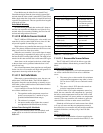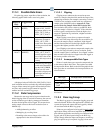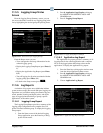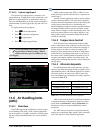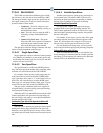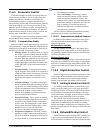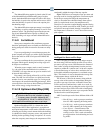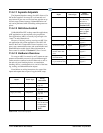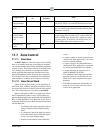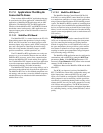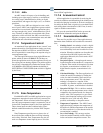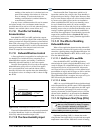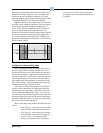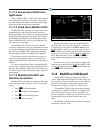
Air Handling Units (AHU) Software Overview • 11-23
air.
The dehumidification setpoint is placed at the 0% end
of the dehumidification PID throttling range. In other
words, the dehumidification output will start at 0% when
the humidity is equal to the setpoint and increase to 100%
when the humidity is equal to or above the setpoint plus
the throttling range.
The dehumidification output percentage is used much
lik
e a heating or cooling output percentage is used in Tem-
perature Control. The percentage represents the percent-
age of total dehumidification
capacity available to the
AHU (including cool stages and other dehumidification
devices).
11.6.9 Curtailment
Some power companies offer curtailment programs
that allow participating stores to disable user-defined loads
during peak power times in return for discounts on utility
rates.
If you are participating in a c
urtailment program, the
power company will supply you with a digital curtailment
device that must be wired to an input on the RS485 I/O
Network.
To set up curtailment in the system software, you must
designate which
specific heating and cooling stages will
be subject to curtailment.
When the power company sends a curtail command
(i.e.,
the value of the curtailment device switches to
“CLOSED”), all stages that are set up to be curtailed will
be shut off and locked out.
Fan control is not directly affected by a
call for curtail-
ment. The AHU fan will still run at a speed based on the
num
ber of active, non-curtailed stages (or, if using modu-
lated outputs, the curtailed modulating percentage). If this
causes th
e fan to slow down or shut off during curtailment,
there will be energy savings from the fans.
11.6.10 Optimum Start/Stop (OSS)
NOTE: OSS applies only to AHU Control ap-
plications that use a time schedule to
change
occupancy states. Overrides initiated by the
digital BYPASS TO OCC or BYPASS TO UN-
OCC inputs will not initiate pre-starts or pre-stops.
Optimum Start/Stop (OSS) is
a feature that works
alongside the AHU Control application’s occupied and
unoccupied temperature control modes. OSS takes control
of heating and cooling several minutes before the building
is scheduled to change occupancy states, and prepares the
building for the upcoming change in setpoints. As a result,
when the occupancy state changes, the temperature will be
comfortably within the range of the new setpoint.
Figure 11-15 shows an example of how pre-starts and
pre-stops work in a heating app
lication. From unoccupied
mode, the pre-start period ramps the temperature up
slowly so that when the scheduled change from unoccu-
pied to occupied mode occurs, the temperature will
already be at or near the occupied h
eating setpoint. During
the pre-stop, which occurs before AHU Control goes from
occupied to unoccupied mode, heating is suspended and
the temperature is allowed to “coast” down to the unoccu-
pied setpoint.
Figure 11-15 - Diagram of Pre-Start and Pre-Stop Operation
OCCUPIED
SET POINT
UNOCCUPIED
SET POINT
UNOCCUPIED
UNOCCUPIED
PRE-START
OCCUPIED
PRE-STOP (COAST)
26512036
Intelligent Pre-Starts and Pre-Stops
OSS is designed to handle pre-starts and pre-stops in
the most energy-efficient manner possible. Every time a
pre-start or pre-stop occurs, OSS measures the amount of
time it takes to bring the temperature from the previous
setpoint to within the “comfort zone” of the new setpoint
(a user-defined range of values above and below the set-
point within which the temperature is c
onsidered accept-
able). This duration is used to determine the average rate
of
temperature change, called the K factor.
The K factor is stored in t
he memory along with the
average value of the outdoor air temperature during the
pre-start or pre-stop. Over time, collected K factor data
will be sorted and combined into a table. As a result, by
constantly observing and recording the results of previous
pre-starts and pre-stops, OSS will be able to intelligently
guess how much time a pre-start or pre-stop mode should
last based on the outside temperature.
AHU Control keeps track of three dif
ferent kinds of K
factors:
• Hea
t K factor - used to guess pre-start dura-
tions for AHUs operating in heating mode.
• Cool K
factor - used to guess pre-start dura-
tions for AHUs operating in cooling mode.
• Co
ast K factor - a measurement of the
change in temperature when no heating or
cooling is active. This is used to determine
pre-stop durations for both heating and cool-
ing AHUs.



